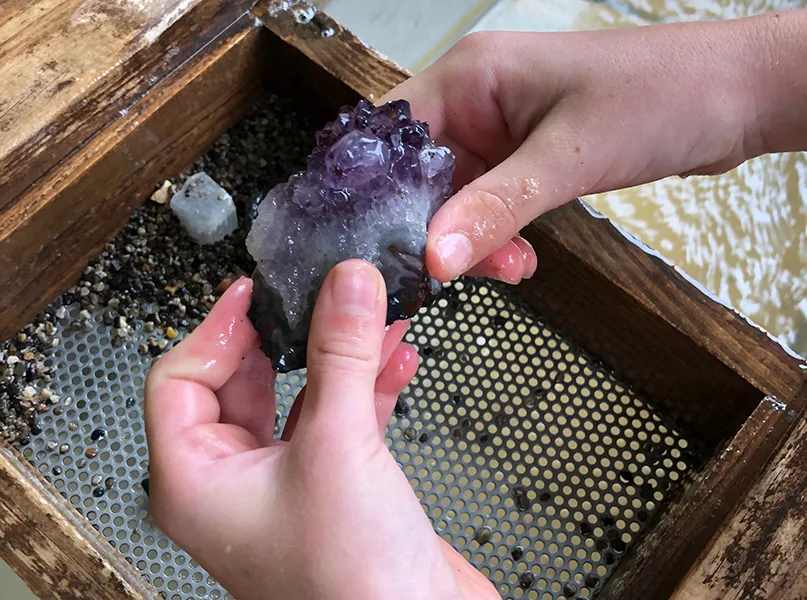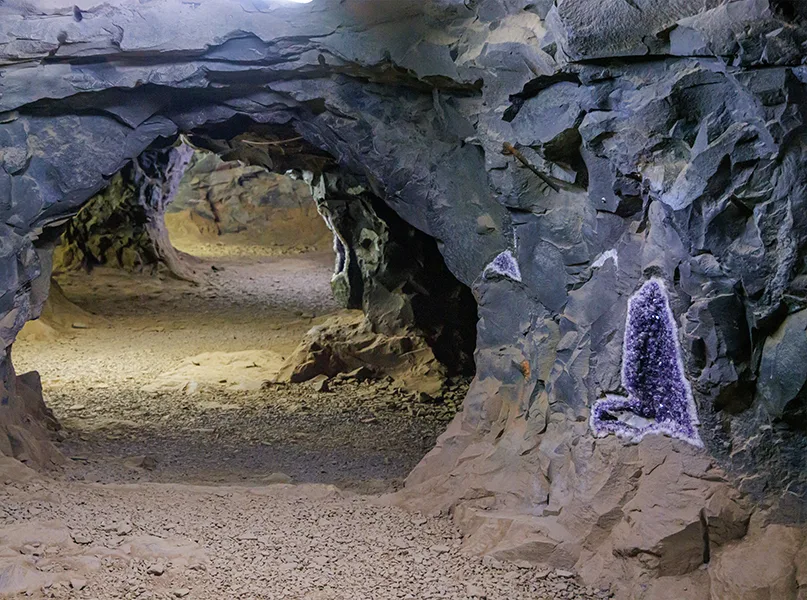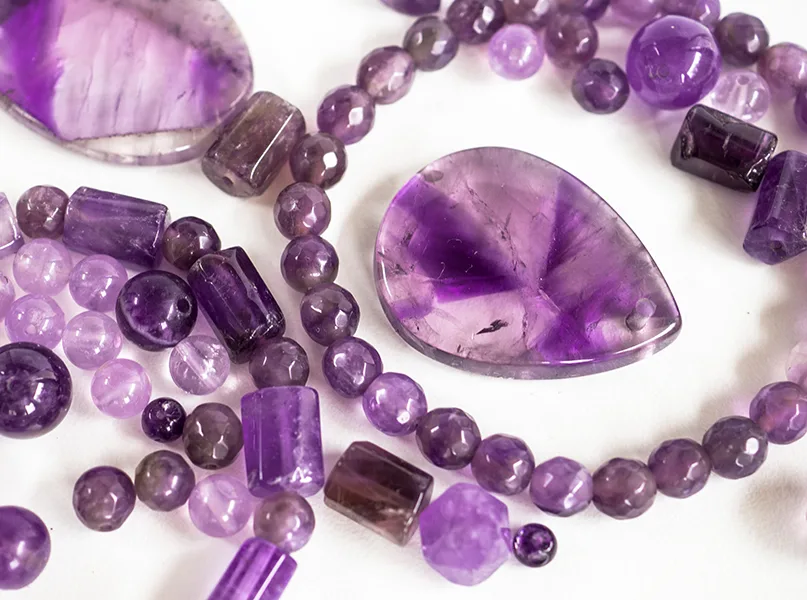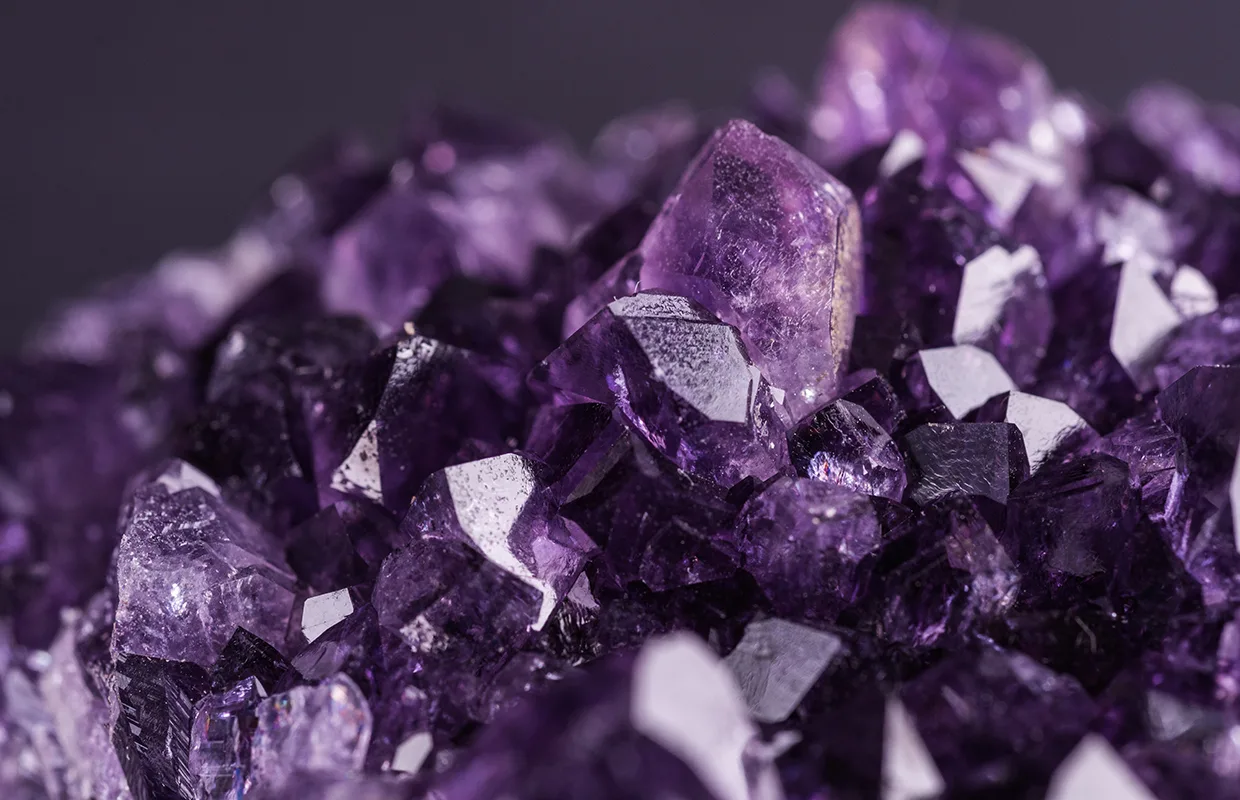We’re unveiling the mystique of the amethyst – nature’s healing gem – known for its velvety hues and rich history. From ancient Greece to modern jewellery designs, discover the timeless charm of these captivating cosmic cuts that have spellbound people throughout the ages.
DIGGING DEEP INTO AMETHYST MINING
The historic love affair with amethysts is due to their enviable desirability as a highly sought-after, stunning variety of quartz, known for their striking spectrum of purple shades, from light lavender and deep violet to plum and mauve.
Amethysts can be found in several forms, including clusters and polished stones extracted from geodes and alluvial deposits worldwide.
Often occurring as 12-sided crystals, open-pit mining is commonly used for shallow deposits, but deeper deposits may require underground methods, including the creation of tunnels or shafts.
Typically found in igneous and metamorphic rocks, with the greatest abundance in volcanic formations, amethysts are composed of silicon dioxide and owe their colour to the presence of iron impurities and natural radiation.
The purple stones have held significance in various cultures throughout history, having been believed to possess protective and healing properties, guarding against intoxication, promoting clarity of thought, enhancing spiritual awareness, facilitating emotional stability, and helping to dispel anger and anxiety.
As such, many people wear them or keep them close for their calming properties of peace and balance.
Historically, amethysts were also associated with royalty and luxury and used in ceremonial objects or worn by nobility to signify status. The iconic Princess Diana once wore an oversized, ornate amethyst cross, which has since only been sparkling on Kim Kardashian’s cleavage at the 2024 Met Gala.
Considered one of the most beautiful jewels by the Royals, Queen Camilla was also seen with a heart-shaped amethyst and pearl necklace, whilst one of her predecessors, Queen Mary, gifted a tiara – part of a parure of regal jewellery – to her daughter-in-law, Queen Elizabeth II’s mother.
Amethysts add a unique element to the royal collection, showcasing the beauty and significance of each treasure.

MINING MAP
Amethysts are sourced diversely as they are widespread across the globe, making them an affordable choice for jewellery, yet their beauty is nothing short of extraordinary, with such rich diversity and unique characteristics.
Madagascar is a notable contributor, alongside Afghanistan and Pakistan; however, Brazil and Uruguay are leading suppliers.
Brazilian amethysts truly shine thanks to their rich colour and remarkable clarity, with prime mining locations in Rio Grande do Sul, Minas Gerais, Bahia, and Maraba. Interestingly, heat-treated amethysts from Minas Gerais can take on a fascinating green hue, captivating jewellers who refer to them as “green amethysts”.
Uruguay, known for its deep purplish-blue amethysts, produces specimens that many consider to be the most beautiful in the world, despite their blemishes. The gems from the capital, Artigas, are particularly celebrated, boasting an unfathomable age of around 130 million years.
On the African continent, Zambia and Namibia emerge as two premier sources of amethysts, beloved for their outstanding clarity. In South Africa, they are also abundant, and artisans often carve these less distinct pieces into beautiful forms.
Whilst Thunder Bay, Ontario and Digby, Nova Scotia are vital stops for amethyst enthusiasts, as the former’s stones are known for their inclusions.
In Europe, the yield from the Zillertal Alps in Austria produces spectacular amethysts. Here, the gems tend to fade more quickly when exposed to sunlight compared to their counterparts found elsewhere. Yet, some unique stones from this region command higher prices than those from Uruguay, for example, due to their exquisite quality.
Meanwhile, the Murinska region of the Ural Mountains in Russia is also home to a noteworthy source of amethysts. These gems have a deep and captivating colour, but due to extensive mining, they have become increasingly rare.
In addition, Hungary’s Zemplén Mountains, with unique amethyst crystals, radiate a silk-like glow, showcasing their translucent beauty. Idar-Oberstein in Germany, famed for its agate, has also seen its amethyst deposits dwindle, halting mining activities in the country.
Elsewhere, Italy produces gems that are evenly coloured and transparent. Found in Osilo, Sardinia, these larger stones shine with clarity, but they lack the deep hues often sought after.
Lastly, Kazakhstan, particularly near Lake Balkhash by Priozersk, is renowned for producing exquisite amethysts. Doubly refractive with striking near-white crystal prisms transitioning to deeper colours at the tips, these stones are a treat for collectors.

ANCIENT AMETHYST ANECDOTES
Amethysts have a deep and storied history dating back to prehistoric times, believed to have been first discovered in France around 25,000 years ago.
However, the cultural significance of amethysts is rooted in ancient Greece, where the gemstones were worn or carved into drinking vessels to prevent intoxication – its name translates as ‘not intoxicate’ from the Greek word ‘amethystos’.
Early Greek legends associate amethysts with Dionysus, the god of wine and pleasure, often depicted holding a goblet or bunch of grapes to symbolise festivity and revelry. Also known to the Romans as Bacchus, he embodies pleasure, ritual madness, and the cycle of life and death, linking wine to both celebration and mourning.
Amethysts have transcended geographical and cultural boundaries, being revered in many different cultures.
In Tibetan Buddhism, for example, the plum-coloured quartz is considered a sacred stone, used in prayer beads called mala to enhance meditation practices.
Elsewhere, amethyst scarabs in ancient Egypt, inscribed with intricate carvings, were used in funerary rituals and associated with royalty, spirituality, and protection.
Later, in medieval Europe, they were a symbol of royalty and religious piety, with their deep purple hue representing purity of spirit and divine favour.
Amethysts have been set in religious artefacts and royal crowns for centuries. Once considered equal in value to rubies, emeralds, and sapphires, and appearing in regalia and rings, the gem adorned the fingers of bishops, as well as symbolising the 12 apostles. In the Old Testament, an amethyst was one of the 12 stones representing the tribes of Israel.
The discovery of large deposits in Brazil in the 18th century transformed the availability and market value of amethysts, cementing their reputation as a beloved jewel.

CONTEMPORARY CULTURE
As with all gemstones, amethysts have their own unique significance and multiple meanings. The highly popular purple stones are used in meditations to heighten spiritual consciousness and are associated with peace and bravery.
Within chakra healing, they are linked to the crown and third eye chakras, thought to enhance spiritual awareness and intuition.
Moreover, they are believed to contain healing properties that speed up and increase the chances of recovery from various health issues and illnesses. In alternative medicine, amethysts are used to aid stress relief, support sobriety, and enhance intuition.
Their vivid colour and unique formations have also had an enduring influence on art and architecture, inspiring artisans and designers throughout history, leading to their use in decorative objects and mosaics.
Today, amethysts have found their way into popular culture as a material in the video game Minecraft. Durable enough for everyday wear, they are also used in jewellery, from rings and necklaces to earrings and bracelets. Their rich purple colour pairs well with both gold and silver, making them versatile in design.
The demand for the prized purple quartz has grown with more people seeking unique jewellery pieces. As a result, certain suppliers, particularly those offering high-quality, deep-coloured stones, can command premium prices.
Amongst these sought-after stones is ametrine, a naturally occurring blend of amethyst and citrine, which showcases stunning gradients of purple and yellow, making each piece individual.
Additionally, cacoxenite amethyst contains inclusions that give it a distinctive appearance of golden threads against the purple backdrop, creating a mesmerising effect.
As amethysts continue to be valued not only for their aesthetic appeal but also for their rich history and cultural significance, they are one of the most beloved gemstones in today’s world, and their universal appeal is a testament to the stone’s unique and enduring charm.
INTRIGUING AMETHYSTS
Amethysts are found on six out of seven of the world’s continents, including Oceania, where a legendary largest ever self-contained geode on Earth was discovered in Australia. Residing in an awe-inspiring creation of nature – the Enchanted Cave – it weighs an astonishing 20 tonnes (t).
Elizabeth Taylor demonstrated her appreciation for historical craftsmanship with a Victorian gold and enamel amethyst bracelet.
Cleopatra famously wore an amethyst ring throughout her relationships with Julius Caesar and Mark Antony.
The Empress of Uruguay is a giant quartz crystal vein – the world’s biggest, it weighs 2.5t and is over seven foot (ft) thick, nearly 6ft wide, and more than 10ft tall. It is valued at USD$190,000, although it is not for sale.
Amethysts rank at seven on the Mohs scale of hardness.



































